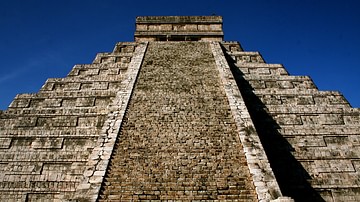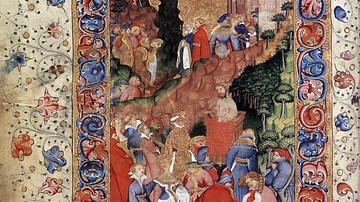The Popol Vuh recounts the story of twins who journeyed to Xibalba. For the Maya, their round of adventures serves as a metaphor for timeless, repeating cycles and for the regeneration of earth and all living things. – Gene S. Stuart, Mayanist
In recent years, there have been many books, and even more websites, concerning the calendar of the ancient Maya and the end of the world in December 2012 CE. There is no need to list and further popularize such works as they can be found easily enough. They are prominently displayed in sections devoted entirely to the subject in popular book stores and even a cursory search of the internet will reveal a multitude of them.
While each separate work and author has its own particular bias and agenda to promote, and so offers a different interpretation of the Maya Calendar, the underlying reasoning for a belief in the end of the world in 2012, at least as associated with the Maya Calendar, runs thusly: The present cycle of the ancient Maya Long Count Calendar begins 11 August 3114 BCE and concludes on 21 December 2012 CE and, because of this, the end of the world is a certainty.

In order for the Maya Calendar to be able to accurately predict an end to the world in any way, it would need to begin at the beginning of the world. It is clear from the archaeological, geological, and historical record that the world is much older than the beginning of the Maya Calendar in 3114 BCE. The great cities of Mesopotamia such as Akkad and Eridu had already risen to their height by the time the calendar is dated as beginning. The dynasties of ancient Egypt were already old and the Chinese and Indian civilizations in full flourish. The Indus Valley Civilization (c. 7000-c.600 BCE), for example, had not even reached its mature stage by 3114 BCE but had already made significant advances.
The Maya calculated the date of 3114 BCE as the beginning of the world based upon an earlier calendar by the Mixe-Zoque people. Their forward astronomical predictions were based upon careful observations of the skies but were understood according to the belief system which governed their understanding of how the universe worked and that understanding was that time was cyclical, not linear. Vastly different from the theological and cosmological understanding espoused by the three great monotheistic religions, time was, itself, a deity, and, as such, had no end. There is, therefore, nothing in the cosmology of the Maya which suggests an end to anything, much less an end to the world.
Legends of Transformation
Maya legends routinely concern themselves with regeneration and transformation. The myth of The Xtabay recounts the lives of Xkeban, the sinner, and Utz-Colel, the virtuous, who transform in death. Xkeban, though considered a sinner for having sex outside of marriage, was more virtuous than the self-righteous and cold Utz-Colel and, when she died, filled the village with sweet perfume and exotic wildflowers known as Xtabentun grew on her grave. Nothing grew on the grave of Utz-Colel but she was transformed into the cactus without scent, the Tzacam, and the flower known as the Xtabay who also appears as a kind of succubus who waylays unsuspecting traveling men, seduces them, and destroys them.
The legend of The Maquech tells the story of the princess Cuzan who falls in love with a man her father does not approve of. A shaman turns Cuzan's lover into an insect which she then keeps with her always. The tale of Nicte Ha follows along the same lines in which the lovers are transformed into a beautiful red bird and a divine lotus which live eternally by the banks of a sacred cenote. The famous Popol Vuh, of course, also follows this same theme.
There is nothing in the literature, religion or in the archaeological evidence to suggest that the concept of `endings', as understood in the western, Judeo-Christian tradition, existed in the world of the Maya and there is nothing in the Maya Calendar which supports an interpretation involving the end of the world. As the above epigraph by the Mayanist Gene S. Stuart attests, the Maya believed in “repeating cycles” and their calendar reflects that belief.
The Maya Calendar
To the Maya, time did not travel in a linear movement from the past into the future but was cyclical, as were the lives of their gods. In the same way that the gods of the Maya were born, developed and sustained themselves and human life, and then died to be re-born, so the years followed the same course. The Maya Calendar contains two separately working calendars which function simultaneously: the Haab, or civil calendar of 365 days in an 18 month period of 20 days each, and the Tzolkin, or sacred calendar, of 260 days divided into three groups of months of 20 days.
The Haab and the Tzolkin work together, like gears interlocking in a machine, to create what is known as the Calendar Round but cannot account for dates farther in the future than 52 years. The Maya believed that it took an individual 52 years to attain wisdom and knowledge of the seen and unseen worlds and so this duration was chosen for dating events in one's lifetime, such as birthdays.
For longer calculations, the Maya devised what is known as the Long Count Calendar and it is this which has attracted so much international attention in recent years regarding the end of the world on 21 December 2012 CE. The Long Count calendar begins 11 August 3114 BCE and goes into its next cycle (known as a Baktun) on 21 December 2012 CE. This is simply a change in the cycle of the calendar – in the same way that people in the modern age observe the end of a year or the end of a century - and there is nothing in the extant writings of the Maya to suggest that any kind of cataclysm accompanies this transition.
Scholarly Opinion
No reputable scholar on Mayan Culture supports the claim that the world will end on 21 December 2012 CE. On 10 May 2012 CE it was reported that Boston University archaeologist William Saturno and Boston University student Maxwell Chamberlain, excavating at the Maya site of Xultun in Guatemala, discovered a 6x6 foot room dating to 800 CE which seems conclusively to have been a calendar workshop for Maya scribes. The paintings and inscriptions on the walls of the room show the Maya calendar extending well beyond the year 2012 CE and that future Baktuns were understood to already be underway in the great cyclic dance of time.
According to David Stuart, an expert on Maya hieroglyphs at the University of Texas at Austin, "Baktun 14 was going to be coming, and Baktun 15 and Baktun 16. ... The Maya calendar is going to keep going, and keep going for billions, trillions, octillions of years into the future." The months of the years of the Maya calendars were governed over each by a specific god and, as these gods were eternally recurring, they assured the continuance of the energy of their particular month and, by extension, the years.
Energy and Transformation
There were four deities in particular, known as The Bearers of the Years (the Bacab) who held the four cardinal points of the sky and imbued a particular year with certain energy. Muluc was the Bacab of the east and his years were always positive in energy. He was associated with the color red. Kan was the Bacab of the south, associated with yellow, and also brought good fortune. Ix, the Bacab of the north was linked with the color white while Cauac, The Bacab of the west's color was black and both of them brought negative energy and bad fortune to the year.
The Bearers of the Years changed each year as the dominant deity of that particular cycle of months and stones were very carefully rearranged on the statues in the villages and cities to denote the change. The Bacabs further reflect the cyclical vision of the Maya and the improbability that this particular culture could devise a calendar system which aimed at any certain end of the world.
Time as Energy
Western interpretations of the Maya Calendar are just that: western. In such an interpretation time is viewed as linear, not cyclical, and, whether a particular writer adheres to Judaism or Christianity or Islam, they are still prone to view time as it has been understood in the scriptures of those religions. In monotheistic western religions God is intimately involved in the affairs of human beings in a straight chronological line from the creation of the world to the present. In Maya polytheism, the gods created the world and then acted more as guides (and sometimes not very pleasant ones) who performed certain functions in accordance with their particular brand of energy and the energy which ran through a given day or month.
`Goodness' was thought to be conserved much in the same way that, in Physics, energy is and the gods granted their goodness to mortals based upon the amount of goodness given to them by human beings. This did not mean, and does not, mean that the gods waited to unleash some final wrath on the world but, rather, that one got what one gave, whether individually or as a community. The relationship between gods and humans was a transfer of energy. The gods were personifications of the planets and of the influences those planets exerted on individuals. Eternity, then, was not a concept involving some future life beyond the earth but was a reality of everyday life for the Maya and they were, and still continue to be, convinced of its continuance on the planet earth.
Conclusion
Interviews conducted by this writer with Maya daykeepers (shamans) at the sites of Chichen Itza and Uxmal revealed that the Maya calendar does not, in any way, predict an `end to the world' but, rather, a new age, a new cycle, in precisely the same way that people in the modern age hope for change and renewal in the new year and make new year's resolutions. If the energy humans send forth toward the gods is good, the energy which returns will be likewise. The end of the Maya Calendar is not an event to be feared but, like any new beginning, is something to be embraced and celebrated as an opportunity to move forward.






